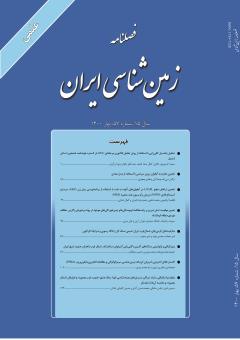تخمین تغذیه به آبخوان مرزی سرخس با استفاده از مدل عددی
محورهای موضوعی :نرگس نبی زاده چمازکتی 1 , هادی جعفری 2
1 - دانشکده علوم زمین، دانشگاه صنعتی شاهرود
2 - دانشکده علوم زمین، دانشگاه صنعتی شاهرود
کلید واژه: آب برگشتی آبیاری, بیلان, تغذیه بارش, خراسان رضوی, مادفلو,
چکیده مقاله :
تخمین تغذیه از مباحث مهم در مطالعات منابع آب زیرزمینی بهخصوص بیلان آبخوانها بوده و در راستای مدیریت بهره برداری از آنها سودمند میباشد. در این تحقیق تغذیه به آبخوان آبرفتی سرخس که تنها منبع تأمين کننده ی آب برای مصارف مختلف شرب، کشاورزی و صنعت در دشت سرخس (شمال شرق ایران و مجاور مرز ترکمنستان) می باشد، با استفاده از مدل مادفلو در نرمافزار فری وات برآورد شده است. پس از ساخت مدل مفهومی آبخوان و تبدیل آن به مدل عددی، فرآیند کالیبراسیون (واسنجی) مدل در شرایط ناپایدار در یک دوره دو ساله (سال آبی 95-1394 و 95-1396) و صحت سنجی آن انجام شده است. بررسی حساسیت مدل عددی به پارامتر تغذیه نشاندهنده توانایی آن در تخمین تغذیه به آبخوان میباشد. بر اساس نتایج مدل عددی میزان تغذیه سطحی سالانه به آبخوان سرخس حدود 80 میلیون مترمکعب بوده که از دو منبع بارش (حدود 32 میلیون مترمکعب در سال) و آب برگشتی کشاورزی (حدود 48 میلیون مترمکعب در سال) صورت می گیرد. بر این اساس ضریب تغذیه ناشی از بارش حدود 20 درصد بارش سالیانه و ضریب جریان برگشتی ناشی از آبیاری برابر 15 درصد تخلیه سالانه چاه های بهرهبرداری برآورد شده است. تغییرات زمانی تغذیه به آبخوان بر اساس مدل عددی کالیبره شده نشاندهنده رخداد تغذیه ناشی از بارش در ماههای دی تا خرداد و جریان برگشتی آبیاری از آبان تا فروردین هر سال می باشد. ضرایب تغذیه در محاسبات بیلان و در راستای مدیریت بهینه آبخوان سرخس و آبخوانهای مشابه در ایران قابل استفاده میباشد.
Estimating recharge is important in groundwater studies, especially in budget calculation to properly manage groundwater withdrawals. In this research, recharge value into the alluvial aquifer of Sarakhs, which is the only source of water for drinking, agricultural and industrial uses in Sarakhs Plain (NE Iran and adjacent to Iran-Turkmenistan border), was estimated using MODFLOW model in FREEWAT Software. After preparing the conceptual model of the aquifer and transforming it into a numerical model, the model was calibrated in unsteady states during a two-year period (water-year 2015-2016 and 2016-2017) and verified. The sensitivity process confirmed validity of the numerical model in estimation of the aquifer recharge. Accordingly, the annual surface recharge was estimated at 80 million cubic meters (Mcm), occurring from rainfall (32 Mcm/year) and irrigation return flows (48 Mcm/year). In this regard, rainfall recharge coefficient was estimated about 20% of the annual rainfall and irrigation return flow coefficient was calculated about 15% of the annual discharge rates of the discharging wells. Simulated temporal variations of the groundwater recharge indicates occurrence of the rainfall recharge during January to June and irrigation return flows from November to April each year. The estimated recharge coefficients can be used in budget studies to properly manage the Sarakhs aquifer, as well as the same aquifers in Iran.
شرکت ملی نفت ایران، 1983. نقشه زمینشناسی سرخس با مقیاس 1:250000.
مهندسین مشاور هیدروتک توس، 1393. گزارش فنی پیشنهاد تمدید ممنوعیت دشت سرخس. کارفرما: شرکت آب منطقهای استان خراسان رضوی،2-6.
نبیزاده، ن.، 1397. تخمین تغذیه سالانه به آبخوان سرخس با استفاده از FREEWAT، پایاننامه کارشناسی ارشد، دانشگاه صنعتی شاهرود، شاهرود، ایران،53-56.
Baalousha, H., 2005. Using CRD method for quantification of groundwater recharge in the Gaza strip. Palestine, Environmental Geology, 48, 889-900.
Bauer, H. H. and Mastin, M. C., 1997. Recharge from precipitation in threeb small glacial-till mantled catchments in the Puget sound Lowland, Washington. US Geological Survey Water Resources Investigation Report, 96-4219.
Brini, N. and Zammouri, M., 2016. Groundwater recharge modelling in semi-arid regions; a case study of El Khairat alluvial plain (Tunisia). Quarterly Journal of Engineering Geology and Hydrogeology, 49,3, 229-236.
Coelho, V. H. R., Montenegro, S., Almeida, C. N., Silva, B. B., Oliveira, L. M., Gusmão, A. C. V. and Montenegro, A. A., 2017. Alluvial groundwater recharge estimation in semi-arid environment using remotely sensed data. Journal of Hydrology, 548, 1-15.
Dripps, W.R., Hunt, R.J. and Anderson, M.P., 2006. Estimating recharge rates with analytic element models and parameter estimation, ground water, 44, 47-55.
Ebrahimi, H., Ghazavi, R. and Karimi, H., 2016. Estimation of groundwater recharge from the rainfall and irrigation in an arid environment using inverse modeling approach and RS. Water Resources Management, 30,6, 1939-1951.
Healy, R. W., 2010. Estimating groundwater recharge, Cambridge University Press, 1-14.
Herrmann, F., Jahnke, Ch., Jenn, F., Kunkel, R., Voigt, H., Voigt, J. and Wendland, F., 2009. Groundwater recharge rates for regional groundwater modelling: a case study using GROWA in the Lower Rhine lignite mining area, Germany. Hydrogeology Journal, 17, 2049–2060.
Izady, A., Abdalla, O., Amerjeed, M., Chen, M., Al-Maktoumi, A., Kacimov, A. and Al-Mamari, H., 2019. Recharge estimation of Hardrock-Alluvium Al-Fara Aquifer, Oman using multiple methods. In Advances in Sustainable and Environmental Hydrology, Hydrogeology, Hydrochemistry and Water Resources, 313-315, Springer, Cham.
Jafari, H., Raeisi, E., Zare, M. and Haghighi, A.A.K., 2012. Time series analysis of irrigation return flow in a semi-arid agricultural region, Iran. Archives of Agronomy and Soil Science, 58,6,.673-689.
Rushton, K., 1997. Recharge from permanent water bodies. In: Simmers I (ed) Recharge of phreatic aquifers in (semi) arid areas. AA Balkema, Rotterdam, 215-255.
Scanlon, B.R., Healy, R.W. and Cook, P.G., 2002. Choosing appropriate techniques for quantifying groundwater recharge. Hydrogeology Journal,10,18-39.
Stoertz, M. W. and Bradbury, K. R., 1989. Mapping recharge area using a groundwater flow model: a case study, Groundwater, 27, 220-228.
Tideman, C. R., Goode, D. J. and Hsieh, P. A., 1997. Numerical simulation of ground-water flow through glacial deposits and crystalline bedrock in the Mirror Lake area, Grafton country, New Hampshire. US Geological Survey Professional Paper 1572.
Uribe, J., Muñoz, J. F., Gironás, J., Oyarzún, R., Aguirre, E. and Aravena, R., 2015. Assessing groundwater recharge in an Andean closed basin using isotopic characterization and a rainfall-runoff model: Salar del Huasco basin, Chile, Hydrogeology Journal, 23,7, 1535-1551.

